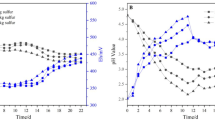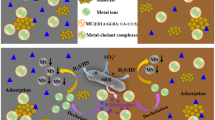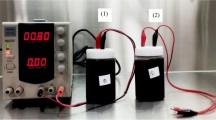Abstract
Stimulation of microbial reduction of Cr(VI) to the less toxic and less soluble Cr(III) through electron donor addition has been regarded as a promising approach for the remediation of chromium-contaminated soil and groundwater sites. However, each site presents different challenges; local physicochemical characteristics and indigenous microbial communities influence the effectiveness of the biostimulation processes. Here, we show microcosm assays stimulation of microbial reduction of Cr(VI) in highly alkaline and saline soil samples from a long-term contaminated site in Guanajuato, Mexico. Acetate was effective promoting anaerobic microbial reduction of 15 mM of Cr(VI) in 25 days accompanied by an increase in pH from 9 to 10. Our analyses showed the presence of Halomonas, Herbaspirillum, Nesterenkonia/Arthrobacter, and Bacillus species in the soil sample collected. Moreover, from biostimulated soil samples, it was possible to isolate Halomonas spp. strains able to grow at 32 mM of Cr(VI). Additionally, we found that polluted groundwater has bacterial species different to those found in soil samples with the ability to resist and reduce chromate using acetate and yeast extract as electron donors.







Similar content being viewed by others
References
American Public Health Association, American Water Works Association, and Water Environment Federation (1999) Standard methods for the examination of water and wastewater. Standard Methods: 541
Armienta MA, Quéré A (1995) Hydrogeochemical behavior of chromium in the unsaturated zone and in the aquifer of Leon valley, Mexico. Water Air Soil Pollut 84(1):11–29
Armienta MA, Rodríguez-Castillo R (1995) Environmental exposure to chromium compounds in the valley of León, México. Environ Health Perspect 103(Suppl 1):47–51
Armienta MA, Rodríguez R, Ceniceros N, Juárez F, Cruz O (1996) Distribution, origin and fate of chromium in soils in Guanajuato, Mexico. Environ Pollut 91(3):391–397
Amoozegar MA, Ghasemi A, Razavi MR, Naddaf S (2007) Evaluation of hexavalent chromium reduction by chromate-resistant moderately halophile, Nesterenkonia sp. strain MF2. Process Biochem 42(10):1475–1479
Anderson RT, Vrionis HA, Ortiz-Bernad I, Resch CT, Long PE, Dayvault R, Karp K, Marutzky S, Metzler DR, Peacock A, White DC, Lowe M, Lovley DR (2003) Stimulating the in situ activity of Geobacter species to remove uranium from the groundwater of a uranium-contaminated aquifer. Appl Environ Microbiol 69(10):5884–5891
Bakradze NG, Abuladze MK, Sokhadze VM, Asatiani NV, Sapojnikova NA, Kartvelishvili TM, Namchevadze EN, Tsibakhashvili NY, Tabatadze LV, Lejava LV, Holman HY (2003) A calorimetric characterization of Cr(VI)-reducing Arthrobacter oxydans at different phases of the cell growth cycle. Sci World J 3:432–442. doi:10.1100/tsw.2003.33
Berendes F, Gottschalk G, Heine-Dobbernack E, Moore ERB, BJ T (1996) Halomonas desiderata sp. nov, a new alkaliphilic, halotolerant and denitrifying bacterium isolated from a municipal sewage works. Syst Appl Microbiol 19(2):158–167
Brito EM, Piñón-Castillo HA, Guyoneaud R, Caretta CA, Gutiérrez-Corona JF, Duran R, Reyna-López GE, Nevárez-Moorillón GV, Fahy A, Goñi-Urriza M (2013) Bacterial biodiversity from anthropogenic extreme environments: a hyper-alkaline and hyper-saline industrial residue contaminated by chromium and iron. Appl Microbiol Biotechnol 97(1):369–378
Brodie EL, Joyner DC, Faybishenko B, Conrad ME, Rios-Velazquez C, Malave J, Martinez R, Mork B, Willett A, Koenigsberg S, Herman DJ, Firestone MK, Hazen TC (2011) Microbial community response to addition of polylactate compounds to stimulate hexavalent chromium reduction in groundwater. Chemosphere 85(4):660–665
Brose DA, James BR (2010) Oxidation-reduction transformations of chromium in aerobic soils and the role of electron-shuttling quinones. Environ Sci Technol 44(24):9438–9444
Chovanec P, Sparacino-Watkins C, Zhang N, Basu P, Stolz JF (2012) Microbial reduction of chromate in the presence of nitrate by three nitrate respiring organisms. Front Microbiol 3:416. doi:10.3389/fmicb.2012.00416
Coppi MV, Leang C, Sandler SJ, Lovley DR (2001) Development of a genetic system for Geobacter sulfurreducens. Appl Environ Microbiol 67(7):3180–3187
Córdoba A, Vargas P, Dussan J (2008) Chromate reduction by Arthrobacter CR47 in biofilm packed bed reactors. J Hazard Mater 151(1):274–279
Dey S, Paul AK (2012) Optimization of cultural conditions for growth associated chromate reduction by Arthrobacter sp. SUK 1201 isolated from chromite mine overburden. J Hazard Mater 213–214:200–206
Duckworth AW, Grant WD, Jones BE, Meijer D, Márquez MC, Ventosa A (2000) Halomonas magadii sp. nov., a new member of the genus Halomonas, isolated from a soda lake of the east African Rift Valley. Extremophiles 4(1):53–60
Field EK, Gerlach R, Viamajala S, Jennings LK, Peyton BM, Apel WA (2013) Hexavalent chromium reduction by Cellulomonas sp. strain ES6: the influence of carbon source, iron minerals, and electron shuttling compounds. Biodegradation 24(3):437–450
Focardi S, Pepi M, Landi G, Gasperini S, Ruta M, Biasio PD, Focardi SE (2012) Hexavalent chromium reduction by whole cells and cell free extract of the moderate halophilic bacterial strain Halomonas sp. TA-04. Int J Biol Biotechnol 66(1):63–70
Fredriksson NJ, Hermansson M, Wilén BM (2013) The choice of PCR primers has great impact on assessments of bacterial community diversity and dynamics in a wastewater treatment plant. PLoS One 8(10):e76431
Garbisu C, Alkorta I, Llama MJ, Serra JL (1998) Aerobic chromate reduction by Bacillus subtilis. Biodegradation 9:133–141
Ge S, Zhou M, Dong X, Lu Y, Ge S (2013) Distinct and effective biotransformation of hexavalent chromium by a novel isolate under aerobic growth followed by facultative anaerobic incubation. Appl Microbiol Biotechnol 97(5):2131–2137
He M, Li X, Guo L, Miller SJ, Rensing C, Wang G (2010) Characterization and genomic analysis of chromate resistant and reducing Bacillus cereus strain SJ1. BMC Microbiol 10:221. doi:10.1186/1471-2180-10-221
Horton RN, Apel WA, Thompson VS and Sheridan PP (2006) Low temperature reduction of hexavalent chromium by a microbial enrichment consortium and a novel strain of Arthrobacter aurescens. BMC Microbiol (6):5
Ibrahim SSA, El-Tayeb MA, Elbadawi YB, Al-Salamah AA (2011) Isolation and characterization of novel potent Cr(VI) reducing alkaliphilic Amphibacillus sp. KSUCR3 from hypersaline soda lakes. Electron J Biotechnol 14(4):4
Lane DJ (1991) 16S/23S rRNA sequencing. In: Stackebrandt E, Goodfellow M (eds) Nucleic acid techniques in bacterial systematics. John Wiley and Sons, Chichester, pp. 115–175
Long D, Tang X, Cai K, Chen G, Chen L, Duan D, Zhu J, Chen Y (2013) Cr(VI) reduction by a potent novel alkaliphilic halotolerant strain Pseudochrobactrum saccharolyticum LY10. J Hazard Mater 256–257:24–32
Lovley DR (1993) Dissimilatory metal reduction. Annu Rev Microbiol 47:263–290
Lovley DR, Phillips EJ (1989) Requirement for a microbial consortium to completely oxidize glucose in Fe(III)-reducing sediments. Appl Environ Microbiol 55(12):3234–3236
Lovley DR, Phillips EJ (1986) Organic matter mineralization with reduction of ferric iron in anaerobic sediments. Appl Environ Microbiol 51(4):683–689
Mabrouk MEM, Arayes MA, Sabry SA (2014) Hexavalent chromium reduction by chromate-resistant haloalkaliphilic Halomonas sp. M-Cr newly isolated from tannery effluent. Biotechnol Equip 28(4):659–667. doi:10.1080/13102818.2014.937092
Mary MS, Vincent S, Janarthanan S, Rao TS, Tata BVR (2011) Bioreduction of Cr(VI) by alkaliphilic Bacillus subtilis and interaction of the membrane groups. Saudi J Biol Sci 18(2):157–167. doi:10.1016/j.sjbs.2010.12.003
Masood F, Malik A (2011) Biosorption of metal ions from aqueous solution and tannery effluent by Bacillus sp. FM1. J Environ Sci Health A Tox Hazard Subst Environ Eng 46(14):1667–1674. doi:10.1080/10934529.2011.623648
Megharaj M, Avudainayagam S, Naidu R (2003) Toxicity of hexavalent chromium and its reduction by bacteria isolated from soil contaminated with tannery waste. Curr Microbiol 47(1):51–54
Messer J, Reynolds M, Stoddard L, Zhitkovich A (2006) Causes of DNA single-strand breaks during reduction of chromate by glutathione in vitro and in cells. Free Radic Biol Med 40(11):1981–1992
Narayani M, Vidya Shetty K (2012) Characteristics of a novel Acinetobacter sp. and its kinetics in hexavalent chromium bioreduction. J Microbiol Biotechnol 22(5):690–698
Piñón-Castillo HA, Brito EM, Goñi-Urriza M, Guyoneaud R, Duran R, Nevarez-Moorillon GV, Gutiérrez-Corona JF, Caretta CA, Reyna-López GE (2010) Hexavalent chromium reduction by bacterial consortia and pure strains from an alkaline industrial effluent. J Appl Microbiol 109(6):2173–2182
Roberts KR, Marzluf GA (1971) The specific interaction of chromate with the dual sulfate permease systems of Neurospora crassa. Arch Biochem Biophys 142(2):651–659
Romano I, Lama L, Nicolaus B, Poli A, Gambacorta A, Giordano A (2006) Halomonas alkaliphila sp. nov., a novel halotolerant alkaliphilic bacterium isolated from a salt pool in Campania (Italy). J Gen Appl Microbiol 52(6):339–348
Sass BM, Rai D (1987) Solubility of amorphous chromium(III)-iron(III) hydroxide solid solutions. Inorg Chem 26(6):2228–2232. doi:10.1021/ic00261a013
Sau GB, Chatterjee S, Mukherjee SK (2010) Chromate reduction by cell-free extract of Bacillus firmus KUCr1. Pol J Microbiol 59(3):185–190
Sayel H, Bahafid W, Joutey NT, Derraz K, Benbrahim KF, Koraichi SI, Ghachtouli NE (2012) Cr(VI) reduction by Enterococcus gallinarum isolated from tannery waste-contaminated soil. Ann Microbiol 62(3):1269–1277
Shapovalova AA, Khizhniak TV, Turova TP, Sorokin D (2009) Halomonas chromatireducens sp. nov., a new denitrifying facultatively haloalkaliphilic bacterium from soda salt marshes capable of aerobic chromate reduction. Microbiology 78(1):117–127 original in Russian
Somenahally AC, Mosher JJ, Yuan T, Podar M, Phelps TJ, Brown SD, Yang ZK, Hazen TC, Arkin AP, Palumbo AV, Van Nostrand JD, Zhou J, Elias DA (2013) Hexavalent chromium reduction under fermentative conditions with lactate stimulated native microbial communities. PLoS One 8(12):e83909. doi:10.1371/journal.pone.0083909 eCollection 2013
Stewart DI, Burke IT, Hughes-Berry DV, Whittleston RA (2010) Microbially mediated chromate reduction in soil contaminated by highly alkaline leachate from chromium containing waste. Ecol Eng 36(2):211–221. doi:10.1016/j.ecoleng.2008.12.028
Stewart DI, Burke IT and Mortimer RJG (2007) Stimulation of microbially mediated chromate reduction in alkaline soil-water systems. Geomicrobiol J 655–669. doi:10.1080/01490450701758221
Sultan S, Hasnain S (2005) Chromate reduction capability of a gram positive bacterium isolated from effluent of dying industry. Bull Environ Contam Toxicol 75(4):699–706
VanEngelen MR, Peyton BM, Mormile MR, Pinkart HC (2008) Fe(III), Cr(VI), and Fe(III) mediated Cr(VI) reduction in alkaline media using a Halomonas isolated from soap lake, Washington. Biodegradation 19(6):841–850. doi:10.1007/s10532-008-9187-1
Varadharajan C, Han R, Beller HR, Yang L, Marcus MA, Michel M, Nico PS (2015) Characterization of chromium bioremediation products in flow-through column sediments using micro-x-ray fluorescence and x-ray absorption spectroscopy. J Environ Qual 44(3):729–738. doi:10.2134/jeq2014.08.0329
Villalobos-Aragon A, Ellis AS, Armienta MA, Morton-Bermea O, Johnson TM (2012) Geochemistry and Cr stable isotopes of Cr-contaminated groundwater in Leon valley, Guanajuato, Mexico. Appl Geochem 27(9):1783–1794. doi:10.1016/j.apgeochem.2012.02.013
Vitale RJ, Mussoline GR, Petura JC, James BR (1994) Hexavalent chromium extractions from soils: evaluation of an alkaline digestion method. J Environ Qual 23(6):1249–1256. doi:10.2134/jeq1994.00472425002300060018x
Vreeland RH, Litchfield CD, Martin EL, Elliot E (1980) Halomonas elongata, a new genus and species of extremely salt-tolerant bacteria. Int J Syst Bacteriol 30(2):485–495. doi:10.1099/00207713-30-2-485
Wang PC, Mori T, Toda K, Ohtake H (1990) Membrane-associated chromate reductase activity from Enterobacter cloacae. J Bacteriol 172(3):1670–1672
Wani PA, Omozele AB (2015) Cr(VI) removal by indigenous Klebsiella species PB6 isolated from contaminated soil under the influence of various factors. Curr Res Bacteriol 8(3):62–69. doi:10.3923/crb.2015.62.69
Watts M, Khijniak TV, Christopher B, Lloyd JR (2015) Treatment of alkaline Cr(VI)-contaminated leachate with an alkaliphilic metal reducing bacterium. Appl Environ Microbiol 81(16):5511–5518
Xu L, Luo M, Li W, Wei X, Xie K, Liu L, Jiang C, Liu H (2011) Reduction of hexavalent chromium by Pannonibacter phragmitetus LSSE-09 stimulated with external electron donors under alkaline conditions. J Hazard Mater 185(2–3):1169–1176. doi:10.1016/j.jhazmat.2010.10.028
Zhang K, Li F (2011) Isolation and characterization of a chromium-resistant bacterium Serratia sp. Cr-10 from a chromate-contaminated site. Appl Microbiol Biotechnol 90(3):1163–1169. doi:10.1007/s00253-011-3120-y
Zhitkovich A (2011) Chromium in drinking water: sources, metabolism, and cancer risks. Chem Res Toxicol 24(10):1617–1629
Ziagova MG, Koukkou AI, Liakopoulou-Kyriakides M (2014) Optimization of cultural conditions of Arthrobacter sp. Sphe3 for growth-associated chromate(VI) reduction in free and immobilized cell systems. Chemosphere 95:535–540. doi:10.1016/j.chemosphere.2013.09.112
Acknowledgments
This work was supported by PAPIIT-UNAM IN208912 grant. LP was the recipient of a CONACyT fellowship. We thank Raunel Tinoco for technical support; Margarita Gutiérrez-Ruiz and Laboratory of Physical and Chemical Analyses of the Environment, Geography Institute; and UNAM, for Cr total quantification. Oligonucleotides and automated sequencing was performed at the Unit for DNA Sequence and Synthesis of the Biotechnology Institute, UNAM.
Author information
Authors and Affiliations
Corresponding author
Additional information
Editorial responsibility: Robert Duran
Rights and permissions
About this article
Cite this article
Lara, P., Morett, E. & Juárez, K. Acetate biostimulation as an effective treatment for cleaning up alkaline soil highly contaminated with Cr(VI). Environ Sci Pollut Res 24, 25513–25521 (2017). https://doi.org/10.1007/s11356-016-7191-2
Received:
Accepted:
Published:
Issue Date:
DOI: https://doi.org/10.1007/s11356-016-7191-2




